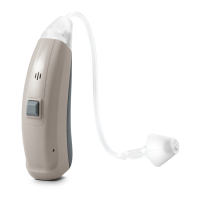
Do you have a question about the Siemens Octiv S and is the answer not in the manual?
| Technology | Digital |
|---|---|
| Battery Size | 312 |
| Receiver in Canal (RIC) | Yes |
| Feedback Cancellation | Yes |
| Noise Reduction | Yes |
| Directional Microphones | Yes |
| Battery Type | Zinc Air |
Difficulty following speech, especially in noisy situations.
Difficulty following speech and misses other quiet noises. Amplification is very successful.
Unable to hear speech even in quiet surroundings. Amplification is very successful.
Unable to hear most sounds unless they are very loud. Amplification is often useful.
Will need amplification technology to hear conversational speech.
A type of hearing aid component, fitted into the ear canal.
A type of hearing aid component, fitted into the ear canal.
Hearing aids work with existing hearing; sound may be strange initially.
Your own voice may sound different due to amplification.
Voice may sound unfamiliar initially, subsides with use.
Additional equipment for TV, telephone, doorbell is available.
Aids adjust but have limitations; manual programs can help specific environments.
It takes time to adjust to new sounds and the physical fit.
Brain needs time to adjust to hearing from the second ear.
Wearing two aids provides balanced sound and easier sound localization.
Ideally wear them all day, every day for best results.
Instructions on how to turn the hearing aid on and off by closing/opening the battery compartment.
Step-by-step guide on how to replace the hearing aid battery.
Explains how to adjust volume using rocker switch or automatic control.
Automatic program adjusting for comfortable, audible speech from all directions.
Reduces background noise and focuses on speech from the front.
Allows hearing sound directly from a microphone in specific public places.
How to position the phone receiver to the hearing aid for better sound.
Details how to select programmed programs and reset to the original program.
Describes the use of optional remote controls like easyPocket for volume and program changes.
Step-by-step instructions on how to insert an ear mould hearing aid correctly.
Steps for cleaning and maintaining ear moulds, including tubing care.
Detailed instructions on how to replace the tubing on an ear mould hearing aid.
Instructions on how to insert a LifeTip hearing aid, securing it behind the ear and in the ear canal.
How to clean and maintain the LifeTube and LifeTip components of the hearing aid.
Advice to keep mouth visible for lip-reading and visual cues.
Use plain language and avoid unnecessary waffle.
Ensure you have the person's full attention before speaking.
Always turn and face the person when talking to provide visual cues.
Keep voice at a normal level; shouting distorts speech.
Choose quiet locations with good lighting for easier communication.
If misunderstood, rephrase and speak more slowly.
Outlines the initial process of hearing assessment and fitting within 5 weeks.
Describes the follow-up appointment within 10 weeks of hearing aid fitting.
Covers ongoing support including batteries, repair, and fitting advice.
Warnings about keeping small parts like batteries away from children.
Advise to check hearing aid condition and consult audiologist for damage.
Guidance on proper battery handling, turning off aids, and removing batteries when not in use.
Guidance on proper battery disposal according to regulations.
Lists environmental and physical factors that can damage hearing aids.
Connect audio input only to equipment conforming to safety requirements.
Advise against using hearing aids in areas with explosion risk.
Troubleshooting steps for no sound, including checking battery and blockages.
Troubleshooting steps for whistling sound, including ear mould fit and wax.
Lists opening hours for repair services at Southport and Ormskirk.
Information on how to book appointments for hearing aid repairs.
Lists common services considered repairs, like servicing and replacing parts.
Lists services not considered repairs, like re-programming volume or tone.
Lists locations in Sefton for battery collection.
Lists locations in Formby for battery collection.
Lists locations in West Lancashire for battery collection.
Contact details and website for Action on Hearing Loss.
Contact details and website for the British Tinnitus Association.
Information and support services from Hearing Link.
Support for deafblind people from SENSE.